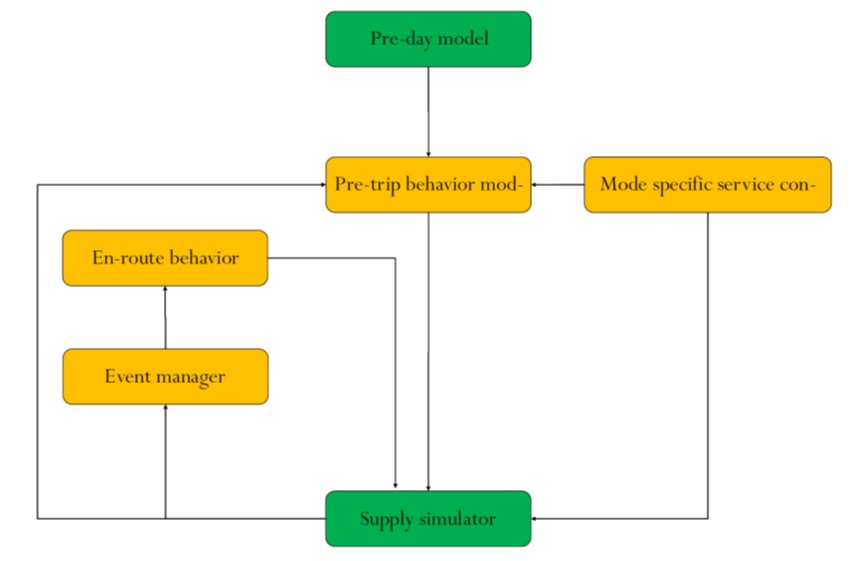-
Notifications
You must be signed in to change notification settings - Fork 29
Within day model
The within-day module of the mid-term simulator is designed to simulate travelers’ various decision making process before and during their trips. The conceptual flow of the within-day module is illustrated by figure 1.
- The within-day pathset generation mode generates and characterizes the set of available paths to go from one origin to a destination node, taking into consideration different transportation modes (bus, taxi, etc.).
- The within-day normal simulation mode simulates the actual movement trajectories, as well as special events (incidents, heavy congestions, etc.), which are notified to the corresponding travelers for en-route decisions.

Figure 1: Main components and conceptual flow of within day simulation
Pre-trip behavior models include departure and route choice model for private traffic and public transport and pre-trip activity rescheduling. The en-route behavior model is to include re-routing and en-route activity re-scheduling (work in progress). The within-day module is an event driven system where all the behavior models are triggered by assorted events. From traveler’s perspective, the simulation flow is driven by a cycle called within-day simulation cycle which is divided into two distinct states: performing activity and undertaking a trip. When a traveler is performing activity, incoming events are handled by corresponding pre-trip behavior models; while when a traveler is undertaking a trip, events are handled by en-route behavior models. The concept of within day simulation cycle is presented by Figure 2.

Figure 2: Traveler’s within day simulation cycle
Note that due to the enormous number of events, it is not feasible to enumerate the definition of each event in this paper. However one of the key tasks of within-day module is to establish connections between different events and corresponding behavior models. And each behavior model may also generate new events according to traveler’s decision in response to external events. Such kind of event chain allows the system to simulate complex interactions between transportation system and travelers and interactions among travelers. In the remaining part of this section, some of the behavior models are briefly explained.
Pathset generation For every Origin-Destination pair a person agent wants to traverse, a pathset is generated in the within day pathset generation mode, adopting a combined method which integrates link elimination method (1), labeling method (2), k-shortest path method (3) and simulation method (4). Each path of the pathsets is characterized by some metrics, like travel cost, travel time, utility, etc.
Taxi GPS points are converted to observed paths through a map matching process based on the SimMobility Singapore road network. Then the coverage of the integrated path set generation algorithm is tested with observed taxi paths. Finally, the utility function of the choice model is 28 estimated based on observed taxi trip paths and the choice set generated by the proposed method using path-size Logit model (5).
The public transport network in mid-term is represented by a directed graph composed of nodes and arcs. Each node represents a bus stop and each arc represents either a route segment or a walking transfer. Here the route segment is defined as a collection of all direct line services between two stops all of which using the same set of road segments. The route choice set generation for public transport network is a combination of labelling method, link elimination method, k-shortest path method and simulation method. EZ-link card data collected in Singapore is used for coverage test and utility function estimation. Similar with private traffic route choice model, detail estimation result and modeling process are not shown here. More discussions will be included in later papers related to SimMobility.
En-route re-routing model for private traffic and public transport (work in progress)
The en-route re-routing model simulates the process of route change caused by various external events. The basic idea of re-routing is to allow drivers (or bus passengers) to modify their current path information during their trips. This model comes into play in the within-day normal simulation mode. The en-route re-routing model (for both private traffic and public transport) consists of five steps: event notification, re-routing point identification, re-routing path set generation, travel/cost update and path modification. In the event notification phase, traveler receives external notification regarding the network condition changes and makes decision on whether or not modify his current path. Then travelers identify all possible nodes from where the current path can be shifted. These nodes can be referred as re-routing nodes or decision nodes. Main factors affect the selection of re-routing nodes include traveler’s current path, current location and the traffic condition of the network. Then in the re-routing path set generation phase, the path set generation algorithm is applied between each re-routing nodes and the destination node in traveler’s current path. By integrating the current path and all the re-routing paths, one can form a new path set from which the new route can be selected using discrete choice model. The link travel time and cost should be updated based on the newest traffic information that is reported to the traveler through the event system.
References:
-
Azevedo, J., Costa, M. S., Madeira, J. S. and Martins, E. V. (1993). An algorithm for the ranking of shortest paths,
European Journal of Operational Research 69: 97106 -
Ben-Akiva, M., Bergman, M., Daly, A. and Ramaswamy, R. (1984). Modeling inter-urban route choice behaviour, Proceeding
of the 9th International Symposium on Transportation and Traffic Theory. -
Yen, J. Y. (1971). Finding the k shortest loopless paths in a network, Management Science 20 17(11): 712–716
-
Ramming, S. (2002). Network knowledge and route choice, PhD thesis, Massachusetts Institute of Technology, Cambridge,
MA -
Ben-Akiva, M., Bierlaire, M., Koutsopoulos, H. N. and Mishalani, R. (1999). Discrete choice methods and their aplications to short-term travel decisions, in R. Hall (ed.), Handbook of Transportation Science